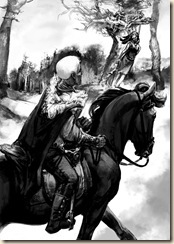"This Is My Corporation, Eat" is a story which sprang into my head during a conversation online with Ken Scholes. Neither of us remember the exact context, just that it had to do with zealotry, the Rapture and our similar early aspirations to religious callings and subsequent, err, loss of fervor.
I nearly shelved this one when it was written, because I worried that  it was too heretical, too much of an indictment to be stomached by a Christian population already highly sensitized to how Christians are portrayed. I worried that the end of the Christian spectrum who enjoy their martyrdom and righteous condemnation would have a distinct and rock-throwy lack of appreciation for my themes.
it was too heretical, too much of an indictment to be stomached by a Christian population already highly sensitized to how Christians are portrayed. I worried that the end of the Christian spectrum who enjoy their martyrdom and righteous condemnation would have a distinct and rock-throwy lack of appreciation for my themes.
I wrote this story in response to zealotry and the commodification of the sacred, in the same way my story "Deadglass" (Writers of the Future XXI) was written in response to the form of religious OCD that the Catholics would recognize as scrupulosity, and my story "The Atrocities of King George" (Ideomancer, June 2010) was written in response to the rationalization and cognitive blanking-out processes that make up a "the ends justify the means" mentality. More recently, I've released a pair of short mashup/experimental novels to Kindle and nook that take on what I see as the flaws in Objectivist Selfishness (The Island of Jayne Grind, with H.G. Wells) and my rejection of the Patriot Act ethos of security trumping liberty (The American in His Season, with Mark Twain and others).
I bring all this up not to shamelessly whore my fiction out, but to lend some background to what makes me tick as a writer and reader. I take themes seriously. I read for that subtle thread, that unifying web of nerve endings that makes a story come alive, moving and wanting and hurting--not for the writer's sake, and not for the reader's sake, but for its own damned sake.
lend some background to what makes me tick as a writer and reader. I take themes seriously. I read for that subtle thread, that unifying web of nerve endings that makes a story come alive, moving and wanting and hurting--not for the writer's sake, and not for the reader's sake, but for its own damned sake.
There is a difference when a story is about something; it's as significant and polarizing as the difference between lightning and lightning bug. I relish digging into the work of writers like Mark Twain and H.G. Wells--or modern masters of tone and theme like Gary Braunbeck and the aforementioned Ken Scholes. Collecting and assembling the sublimely deliberate details, those hundreds of conscious and unconscious decisions they've made in their art which add up to a whole that is something emotional, something true. . . THIS is what makes my brain feel like it's finally using that other 90% people like to talk about.
When I say true, I don't mean true in the sense of verifiable fact, but true in that deeper, human, sacred sense that may well fly in the face of every fact known to science. The sense of authenticity that resonates with one message: I believe in this, and I have to share it.
At first, the third act of this story was not authentic to its beginning.  A set of conversations with a pair of gifted and spiritually adept editors (Jerry Gordon and Edmund Schubert) helped this old secularist find the authenticity that was lacking at long last. The story wasn't meant to end with a tone of fatalistic nihilism, and changes were made to make that clearer. My protagonist's choices are about his own struggle with zealotry, with how easy it is for a man to make his values into tradable commodities. He finds peace in being authentic to himself and to his new understanding of Christ's message of love and tolerance and rejection of the world (in contrast to the Fundie terrorists, who have just as corrosive a focus on the material world as the corporate ministries they blow up).
A set of conversations with a pair of gifted and spiritually adept editors (Jerry Gordon and Edmund Schubert) helped this old secularist find the authenticity that was lacking at long last. The story wasn't meant to end with a tone of fatalistic nihilism, and changes were made to make that clearer. My protagonist's choices are about his own struggle with zealotry, with how easy it is for a man to make his values into tradable commodities. He finds peace in being authentic to himself and to his new understanding of Christ's message of love and tolerance and rejection of the world (in contrast to the Fundie terrorists, who have just as corrosive a focus on the material world as the corporate ministries they blow up).
But has he merely traded one zealotry for another? This is a cautionary tale, after all, and like a great many satires, deadly serious.
I mentioned above how I read to find that sense of the story being about something that matters to the person who wrote it. I try just as hard in my writing to develop a theme that matters to me. To select details and plot events that pertain and resonate and set off the idea I am exploring. I hope that I've accomplished that in this story, though I usually feel like I've missed the mark.
In the end, it's not a verifiable thing. It's only true if you felt the same sense of 'I believe this, and I want to share it' when you read it. Regardless, whether you are a reader or a writer, I hope I've made you think more deeply about theme with this post. (I'm too unconfident to say the same about my story.)
I hope you start to look for it in all your fiction. To demand it.
I hope I've made a zealot out of you.
Lon Prater
Pensacola, Florida
Summer 2011








